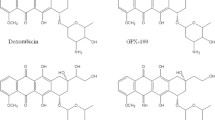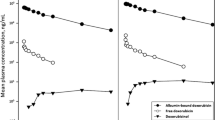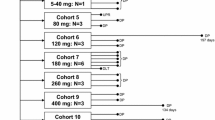Abstract
Improved quality of life has gained importance over shortly lasting remissions in yet incurable metastatic breast cancer. Fractionation of drug administration is one of the possible approaches to reduce the concentration-dependent toxicity of anthracyclines. We evaluated the pharmacokinetics of 4′-O-tetrahydropyranyladriamycin (THP-ADM) under weekly administration in patients with advanced breast cancer (dose escalation, from 20 to 27 mg/m2 THP-ADM). The concentration-time curves of THP-ADM in plasma were best described by an open three-compartment model [half-life of the first disposition phase (t1/2α), 3.15 min; terminal elimination half-life (t 1/2γ), 13.9 h] with a mean area under the curve (AUC) of 12.2 ng h ml−1mg−1m−2, resulting in a mean plasma clearance of 86.91 h−1m−2. Metabolism included the formation of Adriamycin (ADM), Adriamycinol (ADM-OH), 13-dihydro-4′-O-tetrahydropyranyladriamycin (THP-OH), 7-deoxyadriamycinone (7H-ADn), and 7-deoxy-13-dihydroadrimycinone (7H-ADn-OH), with maximal plasma concentrations ranging from 2.8 to 5.5 ng/ml. The mean total amount of cytotoxic anthracyclines excreted into urine, mainly as the parent drug, was 5% of the delivered dose. ADM and ADM-OH, but not the parent drug, were observed in urine at up to 4 weeks after the last therapeutic cycle. There was a significant correlation between the leukocyte nadir under therapy and the AUC of ADM-OH (r=0.800,P<0.05). Since no shift in the plasma kinetics was observed from the first to the sixth cycle, the favorable ratio of the AUCs of THP-ADM and ADM after fractionation of THP-ADM suggests lower toxic side effects attributable to ADM. This hypothesis was confirmed in a clinical study, where no severe cardiotoxicity and only mild alopecia were observed in 19 patients. Thus, pharmacokinetics studies might be helpful in both individualization of therapy with THP-ADM and optimization of the administration schedule.
Similar content being viewed by others
References
Boucek RJ, Olson RD, Brenner DE, Ogunbunmi EM, Inui M, Fleischer S (1987) The major metabolite of doxorubicin is a potent inhibitor of membrane-associated pumps. J Biol Chem 262:15851
Brockmeier D, Lückel G (1991) HOEREP-PC, an interactive program package for the analysis of pharmacokinetic data. Users manual. Hoechst Inc., Frankfurt/Main, Germany
Camaggi CM, Comparsi R, Strocchi E, Testoni F, Angelelli B, Pannuti F (1988) Epirubicin and doxorubicin: comparative metabolism and pharmacokinetics. Cancer Chemother Pharmacol 21:221
Del Tacca M, Danesi R, Solaini G, Bernardini MC, Bertelli A (1987) Effects of 4′-O-tetrahydropyranyl-doxorubicin on isolated perfused rat heart and cardiac mitochondrial cytochrome C oxidase activity. Anticancer Res 7:803
Dittrich C, Baur M, Mader R, Schlappack O, Dudczak R, Leitha T, Lenzhofer R, Hoffmann S, Vieder L, Heberle U, Kaul M, Greifenberg B (1990) Phase I–II study on weekly administration of pirarubicin in patients with metastatic breast cancer. Am J Clin Oncol 13:29
Fujita H, Ogawa H, Tone H, Iguchi H, Shomura T, Murata S (1986) Pharmacokinetics of doxorubicin, 4′-O-tetrahydropyranyladriamycin and aclarubicin. Jpn J Antibiot 39:1321
Iguchi H, Tone H, Ishikura T, Takeuchi T, Umezawa H (1985) Pharmacokinetics and disposition of 4′-O-tetrahydropyranyladriamycin in mice by HPLC analysis. Cancer Chemother Pharmacol 15:132
Maehara Y, Sakaguchi Y, Kusumoto T, Kusumoto H, Sugimachi K (1989) 4′-O-Tetrahydropyranyladriamycin has greater antineoplastic activity than Adriamycin in various human tumors in vitro. Anticancer Res 9:387
Majima H, Iguchi H, Tone H (1986) Pharmacokinetic studies on THP-ADM (tetrahydropyranyladriamycin). Jpn J Cancer Chemother 13:542
Matsushita Y, Iguchi H, Kiyosaki T, Tone H, Ishikura T, Takeuchi T, Umezawa H (1983) A high performance liquid chromatographic method of analysis of 4′-O-tetrahydropyranyladriamycin and their metabolites in biological samples. Jpn J Antibiot 36:880
Miller A, Schmidt C (1987) Clinical pharmacology and toxicity of 4′-O-tetrahydropyranyladriamycin. Cancer Res 47:1461
Multi-institutional cooperative study (1986) Phase II study of (2″R)-4′-O-tetrahydropyranyladriamycin in patients with solid tumors. Jpn J Cancer Chemother 13: 1060
Olson RD, Mushlin PS, Brenner DE, Fleischer S, Cusack BJ, Chang BK, Boucek R (1988) Doxorubicin cardiotoxicity may be caused by its metabolite doxorubicinol. Proc Natl Acad Sci USA 85:3585
Raber MN, Newman RA, Lu K, Legha S, Gorski C, Benjamin RS, Krakoff IH (1989) Phase I clinical trial and pharmacokinetic evaluation of 4′-O-tetrahydropyranyladriamycin. Cancer Chemother Pharmacol 23:311
Rapoport BL, Falkson G (1992) Phase II clinical study of pirarubicin in hormone resistant prostate cancer. Invest New Drugs 10:119
Ratain MJ, Rosner G, Duggan D, Cobau C, Berezin F, Henderson IC, Schilsky RL (1993) Population pharmacodynamic study of single-agent doxorubicin in women with stage III breast cancer. Proc Am Soc Clin Oncol 12:140
Robert J, David M, Huet S, Chauvergne J (1988) Pharmacokinetics and metabolism of pirarubicin in advanced cancer patients. Eur J Cancer Clin Oncol 24:1289
Robert J, Monnier A, Poutignat N, Hrait P (1991) A pharmacokinetic and pharmacodynamic study of the new anthracycline pirarubicin in breast cancer patients. Cancer Chemother Pharmacol 29:75
Sridhar K, Samy TS, Agarwal RP, Duncan RC, Benedetto P, Krishan AG, Vogel CL, Feun LG, Savaraj NM, Richman SP, Zubrod G (1990) A phase I study of 4′-O-tetrahydropyranyladriamycin. Cancer 66:2082
Sridhar KS, Hussein AM, Benedetto P, Ardalan B, Savaraj N, Richman SP (1992) Phase II trial of 4′-O-tetrahydropyranyladramycin (pirarubicin) in head and neck carcinoma. Cancer 70: 1591
Tapiero H, Munck JN, Fourcade A (1986) Relationship between the intracellular accumulation of anthracyclines and effectiveness in vitro and in vivo. Drugs Expl Clin Res 12: 257
Tsuruo T, Lida H, Tsukagoshi S, Sakurai Y (1982) 4′-O-tetrahydropyranyl-adrimycin as a potential new antitumor agent. Cancer Res 42: 1462
Umezawa H, Takahashi Y, Kinoshita M, Naganawa H, Masuda T, Ishizuka M, Tatsuta K, Takeuchi T (1979) Tetrahydropyranyl derivatives of daunamycin and adriamycin. Jpn J Antibiot 32: 1082
Umezawa H, Kunimoto S, Takeuchi T (1987) Experimental studies of new anthracyclines: aclacinomycin, THP-adriamycin and ditrisarubicins. Biomed Pharmacother 41: 206
Author information
Authors and Affiliations
Rights and permissions
About this article
Cite this article
Mader, R.M., Zilg, H., Schlappack, O. et al. Pharmacokinetics of 4′-O-tetrahydropyranyladriamycin given on a weekly schedule in patients with advanced breast cancer. Cancer Chemother. Pharmacol. 37, 91–96 (1995). https://doi.org/10.1007/BF00685634
Received:
Accepted:
Issue Date:
DOI: https://doi.org/10.1007/BF00685634




